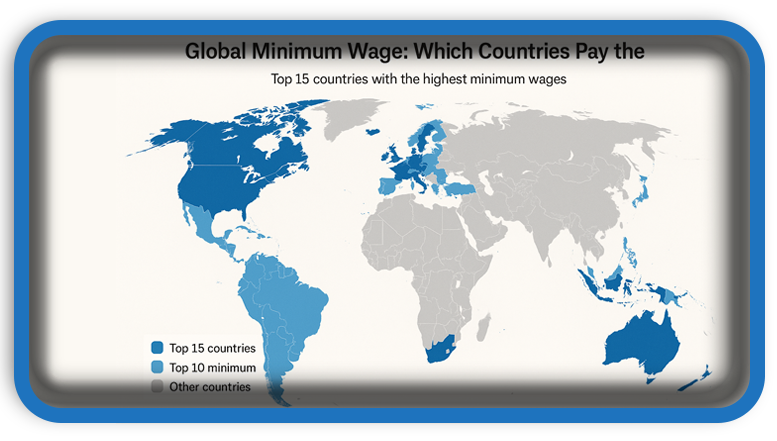⏲️ Estimated reading time: 4 min
🌍 Global Minimum Wage Which Countries Pay the Most? Minimum wages vary drastically across countries, influenced by cost of living, policies, and economic development. Explore a global comparison and discover the top 15 countries with the highest minimum wages.
Understanding the Global Minimum Wage: A Comparative Perspective
The concept of a minimum wage is a cornerstone of labor rights, designed to ensure that workers receive a fair and livable income for their labor. However, the amount set as the minimum wage differs drastically across the globe. These disparities are shaped by factors such as economic health, inflation, political priorities, and living costs.
💼 What is a Minimum Wage?
The minimum wage refers to the lowest legally mandated amount an employer can pay an employee. It is intended to:
- Prevent worker exploitation,
- Support basic living standards,
- Reduce poverty and income inequality.
Minimum wage laws vary not only from country to country but even within regions, especially in federal systems like the United States and India.
🌐 Global Differences in Minimum Wage
Let’s explore how minimum wages vary around the world:
United States
As of 2023, the federal minimum wage remains $7.25 per hour. However, states like California, Washington, and New York have set their minimum wages above $15 per hour, acknowledging higher living costs.
European Union
The EU showcases a wide range:
- Luxembourg: Over €2,200/month – the highest in the world.
- Bulgaria: Under €400/month, among the lowest in the EU.
- France, Germany, and Ireland also rank high with monthly wages above €1,700.
Asia
- Japan and South Korea offer competitive minimum wages.
- India follows a decentralized system where wages differ by state and profession.
- China sets city-specific wages, with Shanghai being the highest.
Africa
- Many African nations have low minimum wages relative to global standards.
- South Africa, since 2019, enforces a national minimum wage (~$1.30/hour).
Latin America
- Brazil: Federal minimum wage is around R$1,302/month (~$270).
- Argentina: Adjusts regularly due to inflation, standing near $180/month.
- Venezuela: Suffers from hyperinflation, rendering its minimum wage virtually useless.
🏆 Top 15 Countries With the Highest Minimum Wages (2024 Estimates)
Here’s a comparative look at countries with the highest statutory minimum wages, converted to USD/month for consistency (approximate):
| Rank | Country | Monthly Minimum Wage (USD) |
|---|---|---|
| 1 | Luxembourg | $2,500+ |
| 2 | Australia | $2,470 |
| 3 | Ireland | $2,300 |
| 4 | France | $2,300 |
| 5 | Germany | $2,250 |
| 6 | Netherlands | $2,200 |
| 7 | New Zealand | $2,200 |
| 8 | Belgium | $2,100 |
| 9 | United Kingdom | $2,000 |
| 10 | Canada (average) | $1,900 |
| 11 | South Korea | $1,750 |
| 12 | Japan | $1,600 |
| 13 | Spain | $1,500 |
| 14 | United States* | $1,200 (Federal), $2,600 (Some states) |
| 15 | Israel | $1,300 |
📌 Note: U.S. values vary by state. California, for instance, mandates $16/hour (~$2,600/month).
⚖️ Challenges and Controversies Around Minimum Wage
While minimum wages aim to ensure dignity and fairness in labor, they aren’t without controversy. Common criticisms include:
❗Potential Job Losses
Raising the minimum wage can pressure small businesses, possibly leading to layoffs or automation.
❗Inflation Erosion
In high-inflation economies, stagnant minimum wages can rapidly lose value, leaving workers underpaid.
❗Regional Disparities
One national minimum wage may not suit all regions due to cost-of-living differences. A wage that is livable in a rural area might not be sufficient in a major city.

💡 How Should Countries Set Minimum Wages?
To be truly effective, minimum wages must:
- Be updated regularly, accounting for inflation.
- Match local cost of living, not just national averages.
- Be enforced effectively, especially in informal economies.
- Be backed by social programs, like healthcare and housing.
🔄 Trends in Global Minimum Wage Policies
Several countries are reassessing or overhauling their wage structures:
- The EU Parliament is pushing for more harmonized minimum wage directives.
- The U.S. is facing national pressure to raise the federal wage for the first time in over a decade.
- Automation and AI adoption are changing the job landscape, affecting how we think about wage floors.

🌟 A Fairer Future for Workers?
Minimum wage is not a one-size-fits-all solution. But when tailored to economic realities and regularly updated, it can:
- Reduce poverty,
- Stimulate the economy,
- Empower workers.
The path to fair wages involves balancing economics with empathy ensuring that no one who works full-time lives in poverty.
🔔 For more tutorials like this, consider subscribing to our blog.
📩 Do you have questions or suggestions? Leave a comment or contact us!
🏷️ Tags: minimum wage, global wages, labor laws, economics, working conditions, wage inequality, EU policies, employment, fair pay, salary comparison
📢 Hashtags: #MinimumWage, #GlobalWages, #FairPay, #LaborRights, #EconomicJustice, #CostOfLiving, #SalaryComparison, #WorkEquity, #LivingWage, #WageGap
🔎 Final Thoughts
Understanding minimum wage policies helps us appreciate the broader fight for economic justice and dignity in the workplace. While some countries lead with high standards, many are still striving to match wages to reality. One thing is clear: fair pay should be a global right, not a privilege.
Only logged-in users can submit reports.
Discover more from HelpZone
Subscribe to get the latest posts sent to your email.

